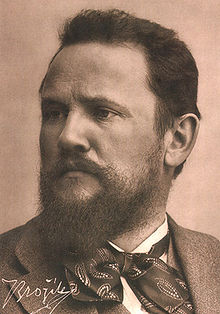art.wikisort.org - Artist
Václav Brožík (French: Vaclav de Brozik pronounced [vɑklav d(ə) bʁoziːk]; 6 March 1851, Třemošná – 15 April 1901 Paris) was a Czech painter who worked in the academic style.
Václav Brožík | |
|---|---|
 Václav Brožík | |
| Born | 6 March 1851 Třemošná, Bohemia, Austrian Empire (now Czech Republic) |
| Died | 15 April 1901 (aged 50) Paris, France |
| Nationality | Czech |
| Education | Academy of Fine Arts in Prague |
| Known for | Painting |
Notable work | Jan Hus before the Council of Constance (1883) Tu Felix Austria Nube (1886) |
| Movement | Academicism |
| Spouse(s) | Hermine Sedelmayer |
| Awards | Gold medal winner at the Salon (1878) Legion of Honour (1884) Ennobled by Emperor Franz Joseph I (1887) |
| Elected | Institut de France (1896) |

Life
He came from a poor family, studying lithography and porcelain painting through apprenticeships. Beginning in 1868, with financial assistance from a local landowner, he was able to attend the Academy of Fine Arts in Prague. He made a trip to the Netherlands, where he studied the Old Masters, then settled in Paris (despite not being able to speak French), where a letter of recommendation assured him the support of Jaroslav Čermák. In 1879 he married Hermina Sedelmeyer, daughter of the wealthy Parisian art dealer Charles Sedelmeyer.[1] For most of his life, he divided his time between Paris and Prague, where he became a Professor at the Art Academy in 1893.
He was named a member of the Institut de France, partly through the influence of his father-in-law, who also suggested that he do a painting on the theme "Tu Felix Austria Nube" (from an old saying: "Let others wage war: thou, happy Austria, marry").[2] The result pleased Emperor Franz Joseph I, who was involved in an unhappy marriage. As a result, Brožík was elevated to the nobility.[1]
He also became a member of the Académie des Beaux-Arts, received the Grand Cross of the Légion d'Honneur[3] and was appointed to the Czech Academy of Arts and Sciences.[4] In 1884, one of his paintings appeared on a United States postage stamp.[5]
His health began to decline in 1894, but he threw himself into painting even more diligently. He died suddenly of heart failure in 1901 and was buried in Montmartre.[1] Appreciation of his work suffered a serious decline after his death, as it was considered old-fashioned, but a major retrospective in 2003 has created some renewed interest.
References
- 4 pictures and biography at Art Renewal Center
- "The World of the Habsburgs: Tu Felix Austria Nube in context". Die Welt der Habsburger.
- Kdo byl kdo v našich dějinách do roku 1918, by Pavel Augusta. Libri, Prague (1998) p.54 ISBN 80-8598-306-0
- Šlechtová, Alena and Levora, Josef: Členové České akademie věd a umění 1890–1952, 2nd edition, Academia Prague (2004) ISBN 80-200-1066-1
- "Gerhard Batz: Das erste Kunstwerk eines tschechischen Künstlers auf Briefmarken (United States postage stamp based on a painting by Brožík)". batz-hausen.de.
Further reading
 Works by or about Václav Brožík at Wikisource
Works by or about Václav Brožík at Wikisource- Osobnosti - Česko : Ottův slovník (Well-known Czechs from Otto's encyclopedia) Ottovo nakladatelství, Prague (2008) ISBN 978-80-7360-796-8
- Vošahlíková, Pavla: Biografický slovník českých zemí, Libri, Prague (2007) ISBN 978-80-7277-248-3
External links
| Wikimedia Commons has media related to Václav Brožík. |
- Works by or about Václav Brožík at Internet Archive
- Slovensko-Česky Klub: Brožík Retrospective
- Novinky: Brožíkův návrat na výsluní (Brožik's Comeback) by Peter Kováč
- Radio Prague: Pražská výstava obrazů Václava Brožíka končí už příští týden (Brožík's Retrospective Ends Next Week) by Evelina Himalová (2003)
На других языках
[de] Václav Brožík
Václav Brožík (* 5. März 1851 in Železný Hamr bei Třemošná, Böhmen; † 15. April 1901 in Paris) war ein tschechischer Maler.- [en] Václav Brožík
[es] Václav Brožík
Václav Brožík (en francés: Vaclav de Brozik; Třemošná, 6 de marzo de 1851 - París, 15 de abril de 1901) fue un pintor checo enmarcado en el academicismo.[fr] Václav Brožík
Václav Brožík alias Vaclav de Brozik (5 mars 1851 à Třemošná en royaume de Bohême – 15 avril 1901 à Paris 8e) est un historien de l'art et peintre d'histoire d'origine bohémien, portraitiste et professeur à l'Académie impériale et royale des Beaux-Arts de Prague, membre associé des Beaux-Arts de Paris.[it] Václav Brožík
Václav Brožík (Třemošná, 5 marzo 1851 – Parigi, 15 aprile 1901) è stato un pittore ceco.[ru] Брожик, Вацлав
Вацлав Брожик (чеш. Václav Brožík; 5 марта 1851 (1851-03-05), Железни-Гамр, Тршемошна — 15 апреля 1901, Париж) — чешский художник, один из крупнейших чешских мастеров XIX столетия.Другой контент может иметь иную лицензию. Перед использованием материалов сайта WikiSort.org внимательно изучите правила лицензирования конкретных элементов наполнения сайта.
WikiSort.org - проект по пересортировке и дополнению контента Википедии